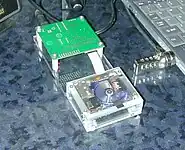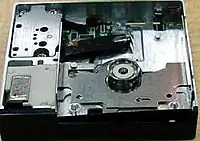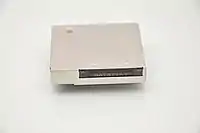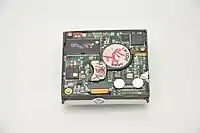DataPlay
DataPlay is an optical disc system developed by DataPlay Inc. and released to the consumer market in 2002. Using very small (32mm diameter) disks enclosed in a protective cartridge storing 250MB per side, DataPlay was intended primarily for portable music playback, although it could also store other types of data, using both pre-recorded disks and user-recorded disks (and disks that combined pre-recorded information with a writable area).[2] It would also allow for multisession recording. [1] It won the CES Best of Show award in 2001. [3]
| Type | Incorporation |
|---|---|
| Founded | 1998[1] |
| Headquarters | |
Key people | Bill Almon, Jr., CEO and President Jeff Roberts, CFO |
| Products | DataPlay Engine DataPlay 500MB Optical Media |
Number of employees | ~30 (2006) |
| Website | www.DataPlay.com (defunct) |
| Optical discs |
|---|
DataPlay also included an elaborate digital rights management system designed to allow consumers to "unlock" extra pre-recorded content on the disk at any time, through the internet, following the initial purchase. It was based on the Secure Digital Music Initiative's DRM system.[2] Dataplay's DRM system was one of the reasons behind its attractiveness to the music industry.[4] It also included a proprietary file system, Dataplay File System (DFS) which natively supported DRM. By default it would allow up to 3 copies to other Dataplay discs, without allowing any copies to CDs.[5]
The recorded music industry was initially generally supportive of DataPlay and a small number of a pre-recorded DataPlay disks were released, including the Britney Spears album Britney. Graphics on press releases show that Sting and Garth Brooks were also set to have DataPlay releases.[6] In 2001 the first DIY DataPlay album was released by the experimental rave producer Backmasker.[7] However, as a pre-recorded format, DataPlay was a failure. The company closed due to a lack of funding. [8][9] In 2003 a company called DPHI bought Dataplay's intellectual property and reintroduced it at CES 2004. The company swapped Dataplay's DFS file system in favor of the FAT file system. Again, they were marketed as a cheaper alternative to memory cards, with a device being designed that would allow users to transfer data from an SD card to a cheaper and higher capacity Dataplay disc. Each disc would hold 500 megabytes of data and be sold at just US$4.50. DPHI also prototyped 750 megabyte Dataplay discs and announced plans for 2 and 7 gigabyte discs, the latter of which would use a blue-violet semiconductor laser, just like Blu-ray.[10]
There were very few products seen on the market that could write data to these discs. Most notable was the Topy Mini Writer, which retailed for $130 (USD) and housed an optical pickup unit (image No.4) with a USB interface board, allowing the use of DataPlay discs much like other end-user writable optical media (e.g., CD-Rs). Other products were the iriver IDP-100[11] and the MTV Video Device "MTV FLIP", which both housed the prototype-based model (image No.2).
Dataplay discs were first proposed as a low cost alternative to memory cards, which used to cost US$3 per megabyte. Blank Dataplay discs, by comparison, would hold 500 megabytes of data at US$10 per disc. They are also expected to have a 100-year lifespan. [2][12][1] The discs would be made out of polycarbonate, just like CDs, but would be just 0.6mm thick, just like one half of a DVD.[5] (DVDs are made up of two halves that are bonded using glue; usually only one (side) contains data)Rewritable Dataplay discs would be similar to CDs, using a phase change alloy protected by a Silicon Oxide layer. [5] Mastered (replicated) Dataplay discs would combine both pits and lands to store mastered data, and grooves containing a wobble frequency to store rewritable data. Just like on CDs, the wobble frequency would store time data, to precisely position the laser on the disc. [5][13]
It has two rewritable areas: one for user data, and the other for encrypted data, the latter of which would hold the decryption keys necessary to unlock the extra content. [5]They also have a Burst cutting area to uniquely identify each disc. [5] Dataplays can transfer data at 1 megabyte per second. [3][14]
Other trademark names:
- DaTARIUS
- DPHI
- Dataplay
Gallery
 Dataplay optical drive engine development photo of a development platform for testing and demo
Dataplay optical drive engine development photo of a development platform for testing and demo Dataplay optical drive engine internals viewed from above a unit produced without any top cover; above the circular piece is the laser pickup. The laser pickup is built on a piece of silicon. [15]
Dataplay optical drive engine internals viewed from above a unit produced without any top cover; above the circular piece is the laser pickup. The laser pickup is built on a piece of silicon. [15] Dataplay optical drive engine with its case (a never-used piece from a private collection)
Dataplay optical drive engine with its case (a never-used piece from a private collection) Dataplay optical drive engine top (same as No.3)
Dataplay optical drive engine top (same as No.3) Dataplay optical drive engine bottom (same as No.3) The large coin-like object is a motor for spinning the disc, and the metal piece at its left is a magnet; the laser pickup of the drive is mounted on an arm that is moved using a mechanism, the latter two of which are reminiscent of that of modern hard disks.
Dataplay optical drive engine bottom (same as No.3) The large coin-like object is a motor for spinning the disc, and the metal piece at its left is a magnet; the laser pickup of the drive is mounted on an arm that is moved using a mechanism, the latter two of which are reminiscent of that of modern hard disks.
References
- "DataPlay Discs Put a New Spin on Digital Music - The Washington Post". The Washington Post. Archived from the original on 2020-04-16.
- "PCWorld.com - DataPlay Shows Breakthrough in Storage Media". June 8, 2001. Archived from the original on June 8, 2001.
- "Consumer Electronics Show 2001". HowStuffWorks. January 11, 2001. Archived from the original on October 28, 2016. Retrieved April 16, 2020.
- "New disc format enters crowded market". Archived from the original on 2020-04-13. Retrieved 2020-04-16.
- "Archived copy" (PDF). Archived (PDF) from the original on 2016-06-24. Retrieved 2020-04-16.
{{cite web}}: CS1 maint: archived copy as title (link) - (PDF). 2001-06-12 https://web.archive.org/web/20010612221719/http://www.dataplay.com/pdf/en/DataPlay_Overview.pdf. Archived from the original (PDF) on 2001-06-12. Retrieved 2021-04-05.
{{cite web}}: Missing or empty|title=(help) - Backmasker -The Anti Clutter Weapon ( DataPlay )Breakbeat Hardcore on worlds rarest music format, archived from the original on 2021-12-21, retrieved 2021-04-26
- "DataPlay shuts down operations". October 3, 2002. Archived from the original on August 12, 2018. Retrieved April 16, 2020.
- "Cash crunch puts media format on hold - Tech News - CNET.com". October 17, 2002. Archived from the original on October 17, 2002.
- "DataPlay Discs Stage a Comeback". PCWorld. October 8, 2004. Archived from the original on March 31, 2019. Retrieved April 16, 2020.
- "iRiver iDP-100 MP3 player". PC World.
- "PCWorld.com - DataPlay's Tiny Media to Ship Next Quarter". November 16, 2001. Archived from the original on November 16, 2001.
- "DataPlay signs distribution deal with Imation - Tech News - CNET.com". September 12, 2001. Archived from the original on September 12, 2001.
- "DataPlay, Imation play with tiny CDRs". June 19, 2001. Archived from the original on August 12, 2018. Retrieved April 16, 2020.
- "Archived copy" (PDF). Archived (PDF) from the original on 2016-06-24. Retrieved 2020-04-16.
{{cite web}}: CS1 maint: archived copy as title (link)
External links
- Official Site (defunct)
- Techmoan: DataPlay: The futuristic optical disc format that time forgot, YouTube, 8 November 2018